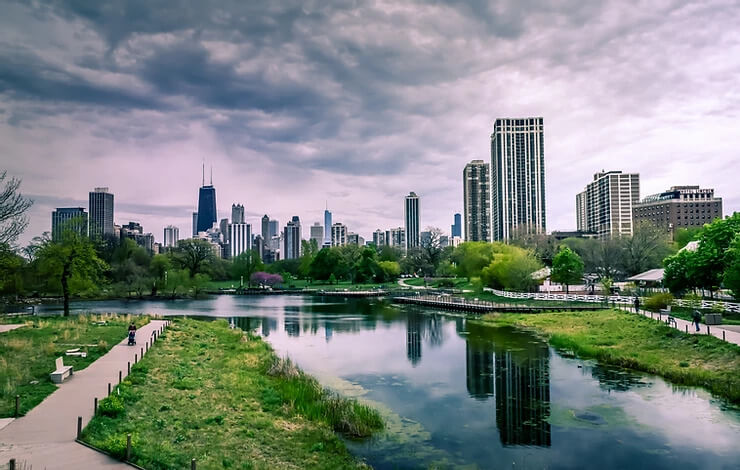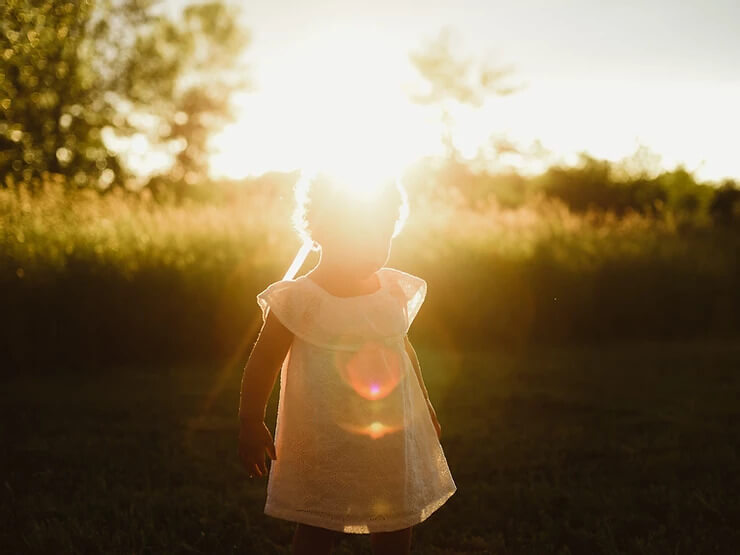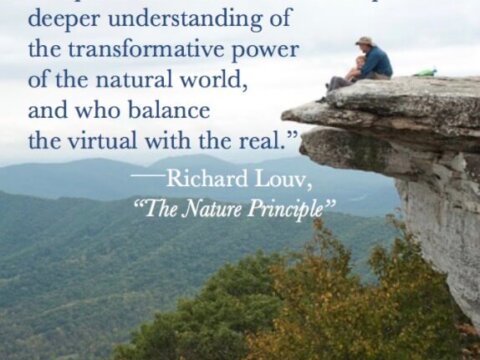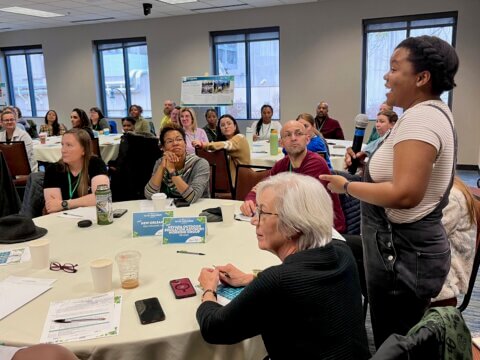10 Nature Activities to Help Get Your Family Through the Coronavirus Pandemic
If the coronavirus spreads at the rate that experts believe it will, schools, workplaces and businesses will continue to close. Here’s a thread of silver lining. We’ll have more time for each other and nature. And, at least so far, nature’s always open.
Getting outside — but at a safe distance from other people — can be one way to boost your family’s resilience. If you spend too much time indoors, “your vitamin D level goes down,” advises John de Pluma, MD, a board-certified internist and proponent of food-based health practices and nature therapy. De Pluma points to research suggesting an association between visiting forests and improving immune responses. Keep in mind that the research he cites is specific to forests outside of cities. But an increasing body of scientific evidence does associate Vitamin N (for Nature) with reduced stress, better mental and physical health and greater cognitive functioning. Connecting with animals (wild and domestic) may also offset the downside of social distancing.
So, here’s a sampling of activities (borrowed from Vitamin N, Our Wild Calling, Last Child in the Woods and other sources) to help your family make the best of a tough situation. These activities all depend on the availability of outdoor spaces, and thinking this through for all of us reminds us of the inequity of park and outdoor space distribution in the United States. Something to take action on after the pandemic lifts.
Pick a “sit spot.” Jon Young, one of the world’s preeminent nature educators, and coauthor of Coyote’s Guide advises children and adults to find a special place in nature, whether it’s under a tree at the end of the yard, a hidden bend of a creek, or a rooftop garden. “Know it by day; know it by night; know it in the rain and in the snow, in the depth of winter and in the heat of summer,” he writes. “Know the birds that live there, know the trees they live in. Get to know these things as if they were your relatives.” Doing so can reduce our sense of isolation, our species loneliness. In addition, building a fort, den, or tree house can help children with problem-solving, creativity, planning and a sense of security and place.
Can’t go outside today? Set up a world-watching window. Bring the outside in. Many of us don’t have the option of hiking or spending time in the backyard. “Find a window view or other view designed to induce feelings of deep relaxation, awe, and vitality—it will take you away from your inward-facing world,” suggests Dr. De Pluma. Air and light pollution prevent two-thirds of the U.S. population and more than half of Europe’s population from seeing the Milky Way with the naked eye. But if your family is lucky enough to live where the stars are visible, stargaze in the evening or very early morning. With your kids, locate a few key constellations and orient to those. Other world-watch window activities can include cloud spotting, bird-watching, and more. Keep handy: a nature notebook, field guides for birds and stars, binoculars, a telescope, a digital camera with a telephoto lens, and maybe even a sound recorder to capture the sounds of the natural world. Other ways to bring the outside in: Indoor plants, as many as possible, will help. Especially native species. No plants? Send for seeds, especially for native plants if you can find them, and make an indoor garden in your apartment or house. Also, keep learning about nature. A friend who lives with her family in an apartment has created a botany class for her kids.
Take a hike or do other exercises outdoors. Where you walk or hike will depend on the degree of social distancing your particular situation requires. In the immediate future, you should probably steer clear of the popular national parks, experiencing far larger than ordinary crowds, creating concern among staffs and health workers. Closer to home, or parks with fewer visitors are more appropriate, for now. With safety issues in mind, both safety from the virus and from people, pick a time for your outdoor walk or hike when fewer people are in the park (if the park is still open) or on the street. Games can help. For example, “Walk this Way.” On their first hike, younger children may enjoy playing a game called “walk this way”—imitating different animals along the way. Bring toys and props that will make it more fun, like hats and fake swords. Walkie-talkies are also a big hit. Encourage kids to take turns as “hike leader,” walking in front and setting the pace. To help kids pay attention during longer hikes, play find ten critters—which means discovering footprints or other signs of an animal passing through. Recommended book: The Down and Dirty Guide to Camping with Kids.

Go backyard, rooftop or deck camping. Buy or borrow a tent or encourage your kids to create their own tepee from a blanket, poles, or sticks. Leave it up all summer. Make s’mores, play flashlight tag, and make shadow puppets on the tent wall. Encourage them to run into the house for provisions from the refrigerator, and back out again. To turn the tent into a homemade observation blind, cut a small window in the side that faces a nearby bird feeder, bat house, or a place frequented by wildlife. Stow binoculars, field guides, a digital camera with a telephoto lens, water, and granola bars. Join the National Wildlife Federation’s annual Great American Backyard Campout. No yard? Before air-conditioning, pitching a hammock, dragging a mattress, or spreading a sleeping bag on a flat roof or fire escape was common.
Got dirt? Set aside a piece of ground in the backyard for kids to dig in. Research suggests that children strengthen their immune systems by playing in the dirt—and weaken those systems by avoiding dirt. In South Carolina, Norman McGee bought a pickup-truck-load of dirt and delivered it to his yard for his kids to dig in. He reports that the dirt pile cost less than a video game and lasted far longer.
Find nature everywhere — and create more of it. National Geographic offers an online guide, Finding Urban Nature that can help city dwellers. If you have a yard, check out the National Wildlife Federation’s guide to building a backyard wildlife habitat: “You can invite wildlife back to your own yard and neighborhood by planting a simple garden that provides habitat. Imagine your garden teeming with singing songbirds, colorful butterflies, flitting hummingbirds, and other small wildlife.” Plant a pollinator garden to help restore biodiversity where you live. Make a mini-pond. Using little more than a tub, sand, a few rocks, and some water, Wildlife Watch UK shows how to make a small oasis for aquatic and amphibious backyard creatures. Book suggestion: Hidden City: Poems of Urban Wildlife, by Sarah Grace Tuttle and Amy Schimler-Safford, for kids and parents. As the publisher describes it, this book as “blend of science and poetry, Hidden City demonstrates that nature can thrive anywhere, even in highly populated areas. In this graceful collection of poems, skyscrapers serve as perches for falcons, streetlights attract an insect buffet for hungry bats, and an overgrown urban lot offers shelter to both flora and fauna.”

Plant a family or friendship tree, or adopt one. Nurturing nature is a positive action to take wherever you live, densely populated urban neighborhood, suburb or small town. Adopt or plant a tree to help mark important family occasions—a holiday, a birth, death, or marriage. The Arbor Day Foundation has information about tree-planting opportunities. Susan J. Tweit, plant biologist and author of Walking Nature Home, offers this suggestion: “Get to know a tree or shrub in your neighborhood intimately by observing it over the course of a growing season. Every week, check your adopted tree or shrub and note any changes.” The Take a Child Outside Week campaign suggests taking pictures of your live family tree in its first snow or after a big windstorm. Make bark rubbings using crayons and paper. Make a digital adoption notebook with photos, videos, and observations. Plant its seeds. To get started, visit Project Budburst or Nature’s Notebook, and set up an account for your adopted tree or shrub. Acts of caring for others and nurturing nature build psychological and spiritual resilience at a time when children and adults most need it.
Be an electronic wildlife watcher. Thanks to the U.S. Fish & Wildlife Service and the National Conservation Training Center, you can watch, in real-time, a bald eagle nest. The web offers many opportunities to view live nature cams. It’s one of many online sites for virtual wildlife viewing. The Cornell Lab of Ornithology invites the public to join the Celebrate Urban Birds project, which provides links to birdcams and kits in Spanish and English. Participants in the project are encouraged to garden, create nature-related art, and observe neighborhood birds, then send the data online to scientists at the Cornell Lab. The project focuses on species of birds often found in urban neighborhoods. Also from Cornell Lab, BirdSleuth.org provides resources for kids K–12, and Feeder Watch helps them protect species by contributing a seasonal tally. At Birdpost.com, young people can post their bird sightings onto satellite maps and track bird populations in their own neighborhoods. Participate in Audubon’s Great Backyard Bird Count.
Give a book that will inspire an outdoor adventure. Most of us can recall our favorite childhood books: picture books, books for early and middle readers, and for young adults. As gift books, the ones that parents and other family members loved when they were children will have special meaning for kids. The books most likely to inspire children to head outdoors aren’t environmental sermons (plenty of time for those later), but about adventure and wonder. Such inspirational titles include Island of the Blue Dolphins, Julie of the Wolves, Tom Sawyer, The Jungle Book, and The Curious Garden. And don’t forget adult family members and friends; inspire them with Robert Michael Pyle’s The Thunder Tree, Jon Young’s What the Robin Knows, Edward Abbey’s Desert Solitaire, and Rachel Carson’s The Sense of Wonder. You can read these books together as a family. Encourage your kids to start their own nature journals. Can’t get outside? Suggest that they write and draw the birds they see in the window, and the nature adventures they’d like to have this summer or next fall.
Tell your own nature stories. When I was researching and writing Our Wild Calling, many people shared their stories with me of transformational encounters and deep relationships with other animals. Sometimes with a pet, other times with a wild animal – a coyote walking through the yard, the mother raccoon and her children, the wounded bird nursed back to health. To the storytellers, these stories held great meaning, and that meaning deepened during the retelling. One of my hopes for this book is that it will encourage you and your family to sit down around the kitchen table or campfire and tell each other stories about animals who have touched your heart. These stories can also be shared on YouTube; through writing, art, and photography; and even through music.
Added thoughts. Boredom is underrated. And sometimes, so is hope. When school shuts down because of bad weather or a virus, boredom can lead to creativity. Especially during summer, parents hear the moaning complaint: “I’m borrrred.” Boredom is fear’s dull cousin. Passive, full of excuses, it can keep children from nature—or drive them to it. Many of us recall how carefully planned activities paled in comparison to more spontaneous experiences, and that boredom often pushed us to create our own stories, which we tell to this day. Sharing those stories is even more important during difficult times. Also, now more than ever, we need to practice using imaginative hope to think seriously about how to create a healthier, nature-rich, more equitable civilization in the years to come.
Note: The Children & Nature Network has consulted with members of the public health community who assure us that encouraging outside time, especially nearby home and at a distance of at least 6 feet from others, is not only safe but recommended for reducing anxiety, depression, loneliness, and other ailments that come with social isolation.
2 Comments
Submit a Comment
-
Network News
Earth Day: Young leaders advocate for change
-
Feature
Nature photographer Dudley Edmondson has a vision for the representation of Black and Brown faces in the outdoors
-
Richard Louv
EARTH MONTH: You're part of the New Nature Movement if....
-
Voices
Placemaking: How to build kinship and inclusive park spaces for children with disabilities
-
Network News
Children & Nature Network founders release report on global factors influencing the children and nature movement








Thank you for all these good news and suggestions !
Since people are hidden in cities with paved roads, and bricks some of them forget being in the wilderness, and even more they are afraid of being outdoors, when the forest , the mountain, the coast lines are wonderful and power places to be cured and refilled of positive energy. More voices and science evidence must be published to show that a BIG part of the cure is in nature.
Love your book and all your writings! So critically important! You’ve influenced my work for years and most recently to initiate an natural outdoor play space – an “Outdoor Play Oasis” in collaboration with a central public library. I’d love to talk with you about the possibility of your speaking/connecting with families at an opening event in May 2022! My mobile is 585-330-4656 Best regards! Deb